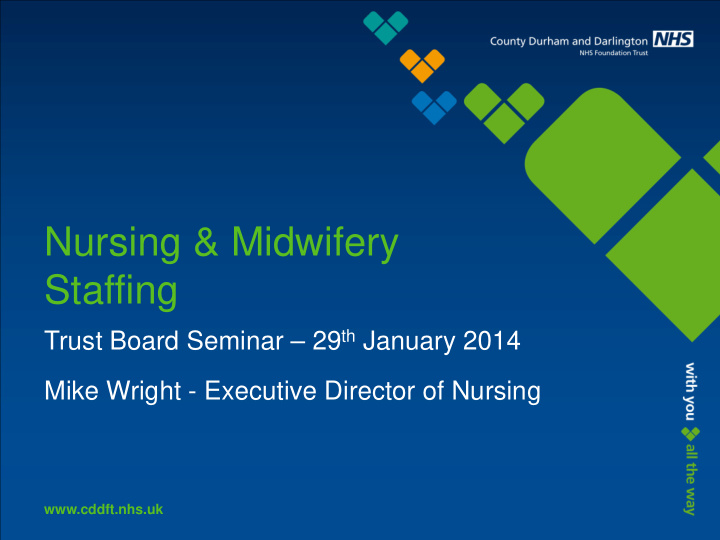



Nursing & Midwifery Staffing Trust Board Seminar – 29 th January 2014 Mike Wright - Executive Director of Nursing www.cddft.nhs.uk
Context Several sentinel events in last 12 months with far reaching consequences for the nursing workforce – Francis, Keogh, Berwick, etc. Unprecedented scrutiny in this area CQC findings = 16% hospitals failing to meet their standards for staffing levels RCN poll – 90% nurses believe staffing levels to be inadequate Not unique to England, or indeed the UK www.cddft.nhs.uk
Context cont. Growing body of evidence of links between RN to patient ratios and risk of increased harm/mortality Calls for nationally-mandated minimum nurse staffing levels, which have not been supported by CNO and government National ‘minimum’ could become ‘maximum’ in financially-challenged times, when there is a need for nursing/care staffing levels to be flexible sometimes to match patient acuity and flow Difference between ‘minimum safe’ and ‘optimum’ www.cddft.nhs.uk
Supply and demand issues Impending nursing shortfall (Kings Fund) – likely reduction of between 0.6% and 11% between 2013 and 2016. Future demand varies from drop by 7% to increase in 23%. Overall = reduction by 2016 Reduction in university commissions in recent years ‘Back and forth’ with international recruitment / ‘Stop- Go’ effect This, in the face of reductions in junior doctor numbers Increasingly ageing nursing workforce www.cddft.nhs.uk
www.cddft.nhs.uk
www.cddft.nhs.uk
Context www.cddft.nhs.uk
www.cddft.nhs.uk
www.cddft.nhs.uk
www.cddft.nhs.uk
www.cddft.nhs.uk
www.cddft.nhs.uk
www.cddft.nhs.uk
www.cddft.nhs.uk
Requirements of NHS Trust Boards Ten ‘Expectations’ 9 for trusts; 1 for commissioners Boards must be able to demonstrate to CQC, NTDA, Monitor, patients and the public that robust systems are in place to assure themselves that nursing, midwifery and care staffing resource www.cddft.nhs.uk
Accountability and Responsibility Expectation 1: Boards take full responsibility for the quality of care provided to patients, and as a key determinant of quality, take full and collective responsibility for nursing, midwifery and care staffing capacity and capability Expectation 2: Processes are in place to enable staffing establishments to be met on a shift-to-shift basis. www.cddft.nhs.uk
Evidence-Based Decision Making Expectation 3: Evidence-based tools are used to inform nursing, midwifery and care staffing capacity and capability Supporting & Fostering a Professional Environment Expectation 4: Clinical and Managerial leaders foster a culture of professionalism and responsiveness, where staff feel able to raise concerns www.cddft.nhs.uk
Expectation 5: A multi-professional approach is taken when setting nursing, midwifery and care staffing establishments Expectation 6: Nurses, midwives and care staff have sufficient time to fulfil responsibilities that are additional to their direct caring duties www.cddft.nhs.uk
Openness and Transparency Expectation 7: Boards receive monthly updates on workforce information, and staffing capacity and capability is discussed at a public Board meeting at least every six months on the basis of a full nursing and midwifery establishment review. Expectation 8: NHS providers clearly display information about the nurses, midwives and care staff present on each ward, clinical setting, department or service on each shift www.cddft.nhs.uk
Planning for future workforce requirements Expectation 9: Providers of NHS services take an active role in securing staff in line with their workforce requirements The role of commissioning Expectation 10: Commissioners actively seek assurance that the right people, with the right skills, are in the right place at the right time within the providers with whom they contract www.cddft.nhs.uk
The use of ‘accredited’ tools No single tool does the ‘whole job’ They are merely guides and are subjective A variety available but not all areas covered e.g. community hospitals and community nursing Not all consider ‘non-direct care giving time’ and other activities, e.g. admissions, discharges, theatre activity, admin., student support, etc. Assessment criteria e.g. patient acuity scoring is highly subjective None consider physical layout of a ward, which has a significant impact www.cddft.nhs.uk
Publishing staffing numbers Requirement to publicise staff on duty on a shift by shift basis – expected versus actual Some concerns being raised about heightening patient anxiety by displaying numbers alone That the numbers become the focus when it’s the skill mix matched to patient acuity that really matters Guy’s & St Thomas’ Hospital NHSFT will not be publishing staffing numbers GSTT has increased nursing and HCA staff by 681 wte between June and September 2013 (1,000 beds). www.cddft.nhs.uk
The CDDFT current position This is a complex thing to get right In the process of reviewing all areas (hospital and community) and using validated tools where available Applying pragmatic professional analysis to determine current requirements Establishing a validation panel, chaired by DoN (with Finance and HR) to review analysis work before finalising recommendations to the Trust Board www.cddft.nhs.uk
Other factors to be resolved Increments and budget setting – not all set at actual costs; 60% RN/M’s and 63% HCA’s at max. pay point Mark up for time-out (annual leave, training, sickness, maternity leave) – different understandings and applications of this (20-22%) Supervisory Ward Sister-Charge Nurse/Team Leader Establish a ‘risk rating’ – proportion away from desired numbers www.cddft.nhs.uk
Cont. DMH v UHND recruitment challenges Need to establish Rota Rules (bare acceptable minimum standards), which will alert to any on-going concerns Need to agree standardised process for collecting and publishing this information regularly and publically Paper to the Trust Board in March 2014, then 6- monthly thereafter Work needs to integrate with IBP timelines www.cddft.nhs.uk
Recommend
More recommend